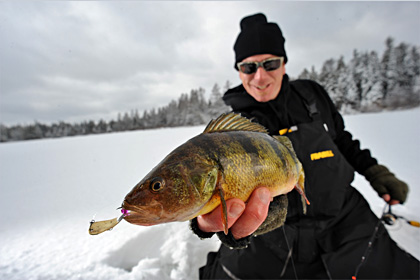

By Jeff Nedwick on Mar 15, 2014 with Comments 0
Three months of bitter cold and snow can make even the most dedicated ice anglers yearn for open water and warm weather. But for die-hards willing to chase Lake St. Clair’s jumbo perch late into winter, the best fishing is just beginning.
Mid-winter ice fishing on Lake St. Clair can be difficult. Perch that were in canals and marinas at first ice now spend much of their time roaming the vast open flats of the main lake in search of food. To be successful under these conditions, ice anglers must travel long distances and cover lots of water to locate widely dispersed schools.
But as winter wanes and main lake ice begins to break up, perch return to many of these same shorelines, bays and canals.
While the early ice migration was driven exclusively by opportunistic feeding on abundant prey – shiners in most cases – the late ice migration is largely driven by reproductive needs as perch seek out shallow water with remaining vegetation where they will eventually spawn when water temperatures reach the mid-forties.
The key to successful late Lake St. Clair perch fishing is finding areas where remaining ice cover adjoins or covers spawning habitat.

Pro angler Joe Balog with a late ice jumbo yellow perch from Lake St. Clair. Photo Credit: Millennium Promotions, Inc.
Bass fishing tournament professional and lure designer Joe Balog is one of the last to hang up his ice fishing cleats, chasing perch on Lake St. Clair as soon as ice begins to form in late fall until the last of the ice is gone in spring. His unique approach to finding and catching late ice jumbo perch is largely based on his tournament fishing expertise.
Like tournament bass fishing, ice anglers who are the quickest and most efficient at locating fish are usually the most successful. Balog searches for late ice concentrations of perch much like he would practice for a bass tournament – by methodically fishing potential areas quickly and rarely staying in one spot for more than 15 minutes if he’s not catching fish.
Balog travels light, carrying a minimal amount of gear – a bucket to sit on and hold fish, a portable flasher if the wind has muddied the water and a couple of ice rods.
The benefits of travelling light extend beyond mobility – they also make it easier to avoid spooking perch. Manual augers are not only lighter than gas powered augers, they’re far less noisy. A bucket not only weighs less than a sled or portable shanty, it eliminates the noise created when those items are dragged across the rough surface of the ice. “I’ve seen perch through my ice fishing hole scatter at the sound of footsteps as another angler walked by,” says Balog. For that reason, he only uses ice cleats or grips on his boots when absolutely necessary and if perch are extremely wary, he uses unusually long ice fishing rods – up to four and one half feet – that allow him to stand at a further distance from the hole.
Once perch are located, Balog relies entirely on artificial lures to catch them. “Live bait is simply not necessary,” he says. His preferences fall into one of four basic groups; beaded spoons – also known as “Russian spoons”, jigging spoons tipped with a scented artificial egg, jigs and plastic trailers – especially ice jigs made from tungsten which pack much more weight into a smaller profile – and jigging minnows like the Jigging Rap.
Anglers also need to be aware of the tendency for perch to suspend higher in the water column this time of year, sometimes just under the ice. It’s not clear whether this is driven by increased oxygen levels in water near the surface or merely an aggressive feeding behavior, but anglers should never leave a hole without checking out the top half of the water column.
No story about late winter ice fishing on Lake St. Clair would be complete without mentioning the need for additional safety precautions. Mid-winter hot spots like stress cracks become extremely dangerous late in the year when offshore winds can blow large sections of ice toward main lake open water. Fortunately, the best late ice areas on Lake St. Clair are almost always close to shore so it’s not necessary to cross these areas to find perch.
The winter of 2013 – 2014 will be remembered as one of the longest ice fishing seasons in recent memory but anglers who hang in there a little longer might be rewarded with the best fishing of the year.
Filed Under: Featured • Ice Fishing Tips • Yellow Perch
About the Author: